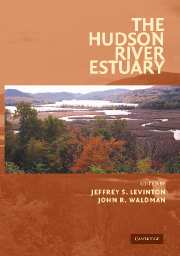Book contents
- Frontmatter
- Contents
- Preface
- List of Contributors
- The Hudson River Estuary
- 1 The Hudson River Estuary: Executive Summary
- GEOLOGICAL, PHYSICAL, AND CHEMICAL SETTING OF THE HUDSON
- PRIMARY PRODUCTION, MICROBIAL DYNAMICS, AND NUTRIENT DYNAMICS OF THE HUDSON
- HUDSON RIVER COMMUNITIES, FOOD WEBS, AND FISHERIES
- CONTAMINANTS AND MANAGEMENT ISSUES OF THE HUDSON RIVER ESTUARY
- 22 The History and Science of Managing the Hudson River
- 23 Hudson River Sewage Inputs and Impacts: Past and Present
- 24 PCBs in the Upper and Tidal Freshwater Hudson River Estuary: The Science behind the Dredging Controversy
- 25 Transport, Fate, and Bioaccumulation of PCBs in the Lower Hudson River
- 26 Contaminant Chronologies from Hudson River Sedimentary Records
- 27 Atmospheric Deposition of PCBs and PAHs to the New York/New Jersey Harbor Estuary
- 28 Toxic Substances and Their Impact on Human Health in the Hudson River Watershed
- 29 Impacts of Piers on Juvenile Fishes in the Lower Hudson River
- 30 Physiological and Genetic Aspects of Toxicity in Hudson River Species
- Index
- Plate section
- References
27 - Atmospheric Deposition of PCBs and PAHs to the New York/New Jersey Harbor Estuary
Published online by Cambridge University Press: 06 January 2010
- Frontmatter
- Contents
- Preface
- List of Contributors
- The Hudson River Estuary
- 1 The Hudson River Estuary: Executive Summary
- GEOLOGICAL, PHYSICAL, AND CHEMICAL SETTING OF THE HUDSON
- PRIMARY PRODUCTION, MICROBIAL DYNAMICS, AND NUTRIENT DYNAMICS OF THE HUDSON
- HUDSON RIVER COMMUNITIES, FOOD WEBS, AND FISHERIES
- CONTAMINANTS AND MANAGEMENT ISSUES OF THE HUDSON RIVER ESTUARY
- 22 The History and Science of Managing the Hudson River
- 23 Hudson River Sewage Inputs and Impacts: Past and Present
- 24 PCBs in the Upper and Tidal Freshwater Hudson River Estuary: The Science behind the Dredging Controversy
- 25 Transport, Fate, and Bioaccumulation of PCBs in the Lower Hudson River
- 26 Contaminant Chronologies from Hudson River Sedimentary Records
- 27 Atmospheric Deposition of PCBs and PAHs to the New York/New Jersey Harbor Estuary
- 28 Toxic Substances and Their Impact on Human Health in the Hudson River Watershed
- 29 Impacts of Piers on Juvenile Fishes in the Lower Hudson River
- 30 Physiological and Genetic Aspects of Toxicity in Hudson River Species
- Index
- Plate section
- References
Summary
abstract The objective of this work is to quantify the atmospheric inputs of polychlorinated biphenyls (PCBs) and polycyclic aromatic hydrocarbons (PAHs) to the New York/New Jersey Harbor Estuary. Atmospheric deposition was quantified by measuring eighty-six PCBs and thirty-four PAHs in air (gas and aerosol) and precipitation at three sites: Jersey City (Liberty Science Center), Sandy Hook, and New Brunswick. These sites are part of the New Jersey Atmospheric Deposition Network (NJADN), a research and monitoring network operated on a twelve-day sampling frequency since 1997. The measured concentrations in the three media were used to calculate atmospheric deposition fluxes to the estuary via three processes: (1) gas absorption, (2) dry particle deposition, and (3) wet deposition. Concentrations of PCBs and PAHs were generally highest at Liberty Science Center and lowest at Sandy Hook. For the sum of all PCBs measured (ΣPCBs), these three modes combined deposit between 21 and 56 μg m−2 yr−1 to the estuary, or about 13 to 41 kg yr−1. Gas absorption is the dominant mode of deposition for most PCBs, due to their relatively high vapor pressures, which cause them to exist primarily in the gas phase in the atmosphere. This input is small compared to the inputs to the estuary from wastewater treatment plants and the upper Hudson River, and also in comparison to the volatilization of PCBs from the water column to the atmosphere. It is two to ten times larger, however, than atmospheric deposition fluxes of PCBs to similar ecosystems, such as the Great Lakes and Chesapeake Bay.
- Type
- Chapter
- Information
- The Hudson River Estuary , pp. 398 - 412Publisher: Cambridge University PressPrint publication year: 2006

